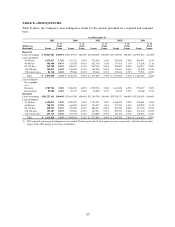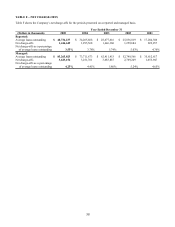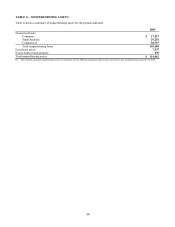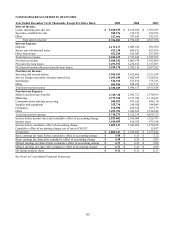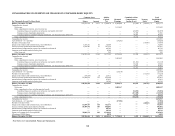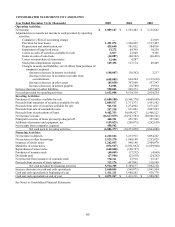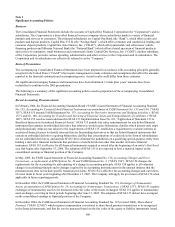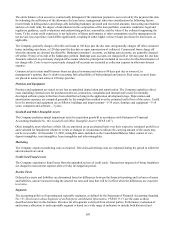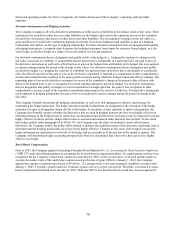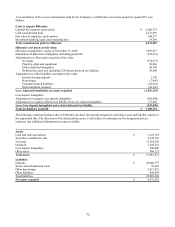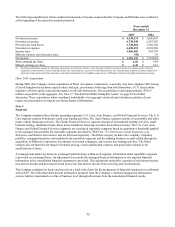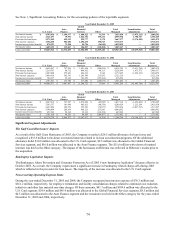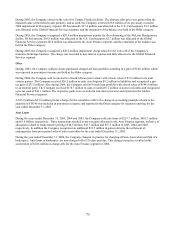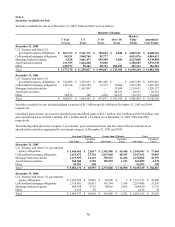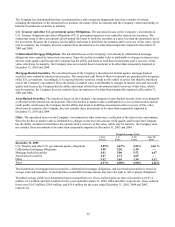Capital One 2005 Annual Report Download - page 76
Download and view the complete annual report
Please find page 76 of the 2005 Capital One annual report below. You can navigate through the pages in the report by either clicking on the pages listed below, or by using the keyword search tool below to find specific information within the annual report.The Securities and Exchange Commission (“SEC”) issued an amendment in April 2005 deferring the effective date of SFAS
123 (R) to begin with the first interim or annual reporting period of the Company’ s fiscal year which would be after
December 15, 2005 for the Company. In December 2003, the Company adopted the expense recognition provisions of
Statement of Financial Accounting Standard No. 123, Accounting for Stock Based Compensation, (“SFAS 123”), under the
prospective method allowed by Statement of Financial Accounting Standard No. 148, Accounting for Stock-Based
Compensation—Transition and Disclosure—an amendment of FASB Statement No. 123, (“SFAS 148”), to all awards
granted, modified, or settled after January 1, 2003. The provisions of SFAS 123(R) must be applied using the modified
prospective method which requires the Company to recognize compensation expense for the unvested portion of all awards
granted prior to January 1, 2003. The adoption of SFAS 123(R) will not have a material impact on the consolidated earnings
r financial position of the Company. o
In December 2003, the Accounting Standards Executive Committee (“AcSEC”) issued Statement of Position 03-3,
Accounting for Certain Loans or Debt Securities Acquired in a Transfer, (“SOP 03-3”). SOP 03-3 addresses accounting for
differences between contractual cash flows and cash flows expected to be collected from an initial investment in loans
acquired in a transfer if those differences are attributable, at least in part, to credit quality. It applies to individual loan
purchases, portfolio purchases, and loans acquired in a purchase business combination. It does not apply to loans to
borrowers in good standing under revolving credit agreements (which include credit cards and home equity loans), mortgage
ans held for sale, and loans originated by the Company. lo
The Company’ s acquired loans, subject to SOP 03-3, are recorded at fair value and no separate valuation allowance is
recorded at the date of acquisition. The Company reviews each loan at acquisition to determine if it should be accounted for
under SOP 03-3 and if so, determines whether each such loan is to be accounted for individually or whether such loans will
be aggregated into pools of loans based on common risk characteristics. The Company makes an estimate of the total cash
flows it expects to collect from the loans (or pools of loans), which includes undiscounted expected principal and interest.
The excess of that amount over the fair value of the loans is referred to as accretable yield. Accretable yield is recognized as
interest income on a constant yield basis over the life of the loans. Any adjustments to the acquisition date fair value of the
acquired loans made during the refinement of the allocation of purchase price will impact accretable yield. The Company also
determines the loans’ contractual principal and contractual interest payments. The excess of that amount over the total cash
flows it expects to collect from the loans is referred to as nonaccretable difference, which is not accreted into income. The
Company continues to estimate cash flows expected to be collected over the life of the loans. Subsequent increases in total
cash flows it expects to collect are recognized as an adjustment to the accretable yield with the amount of periodic accretion
adjusted over the remaining life of the loans. Subsequent decreases in cash flows expected to be collected over the life of the
loans are recognized as impairment in the current period through a valuation allowance. SOP 03-3 is effective for loans
acquired in fiscal years beginning after December 15, 2004. See Note 7 for further discussion of SOP 03-3.
In January 2003, the FASB issued FASB Interpretation No. 46, Consolidation of Variable Interest Entities, an Interpretation
of ARB No. 51 (“FIN 46”). In December 2003, the FASB issued FASB Interpretation 46 (Revised December 2003),
Consolidation of Variable Interest Entities, and Interpretation of ARB No. 51 (“FIN 46(R)”) to provide clarification of
certain provisions of FIN 46 as originally issued, and to defer the effective dates for certain entities. These interpretations
address consolidation of business enterprises of variable interest entities (“VIEs”), which have certain characteristics. These
characteristics include either that the equity investment at risk is not sufficient to permit the entity to finance its activities
without additional subordinated financial support from other parties; or that the equity investors in the entity lack one or more
of the essential characteristics of a controlling financial interest. The Company elected to early adopt the provisions of FIN
46 for the interim period ended September 30, 2003. The Company has consolidated all material VIEs for which the
Company is the primary beneficiary, as defined under FIN 46, effective July 1, 2003. The Company recorded premises and
equipment of $139.8 million, other borrowings of $178.3 million and recognized a charge of $15.0 million, net of tax, for a
cumulative effect of a change in accounting principle for the year ended December 31, 2003.
C
ash and Cash Equivalents
Cash and cash equivalents includes cash and due from banks, federal funds sold and resale agreements and interest-bearing
deposits at other banks. Cash paid for interest for the years ended December 31, 2005, 2004 and 2003 was $1.9 billion, $1.8
billion and $1.6 billion, respectively. Cash paid for income taxes for the years ended December 31, 2005, 2004 and 2003 was
$654.8 million, $705.1 million and $571.2 million, respectively.
Securities Available for Sale
The Company classifies all debt securities as securities available for sale. These securities are stated at fair value, with the
unrealized gains and losses, net of tax, reported as a component of cumulative other comprehensive income. The amortized
cost of debt securities is adjusted for amortization of premiums and accretion of discounts to maturity. Such amortization or
accretion is included in interest income. Realized gains and losses on sales of securities are determined using the specific
67


